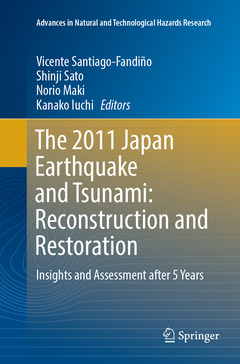The 2011 Japan Earthquake and Tsunami: Reconstruction and Restoration, Softcover reprint of the original 1st ed. 2018 Insights and Assessment after 5 Years Advances in Natural and Technological Hazards Research Series, Vol. 47
Coordonnateurs : Santiago-Fandiño Vicente, Sato Shinji, Maki Norio, Iuchi Kanako

This book covers the restoration and reconstruction process and activities undertaken in Japan in the first five years since the 2011 Earthquake and Tsunami ? a period widely considered to be the most intensive reconstruction phase within the 10-year restoration plan drawn up by the Japanese Government.
The respective chapters explore technical, scientific, social and non-scientific (policy-related) aspects, including: reconstruction and restoration policies, infrastructure and designs for tsunami coastal defence, resilient urban areas and affected communities, housing and relocation schemes, disaster mitigation and evacuation measures, reactivation of the economy, revitalization of fisheries and coastal agriculture, and industry and tourism. The book also illustrates some of the achievements and failures in a broad range of projects and initiatives intended to address the above-mentioned issues, making it particularly relevant for experts, decision makers, students and other interested scholars.
<
Compiles new information and knowledge about the restoration and reconstruction activities undertaken over a five years period in one of the most earthquake and tsunami devastated coastal areas in the world
Illustrates the achievements and failures of plans and activities supported by large financial resources and human efforts in different sectors during 5 years
Compiles real case situations on technical, scientific, social and non-scientific (i.e. management and policy) fields
Presents chapters written by well-known experts
Serves as a reference work due to its wide scope and topics
Date de parution : 09-2018
Ouvrage de 485 p.
15.5x23.5 cm
Date de parution : 07-2017
Ouvrage de 485 p.
15.5x23.5 cm
Thèmes de The 2011 Japan Earthquake and Tsunami: Reconstruction... :
Mots-clés :
Restoration and reconstruction in Japan 2011 Earthquake; Earthquake and tsunami Japan 2011; Five years after March 2011 Japan Earthquake; Coastal area devastation after tsunami Japan 2011; Restoration activities after 2011 Japan earthquake and tsunami; coastal sciences; landscape/regional and urban planning



